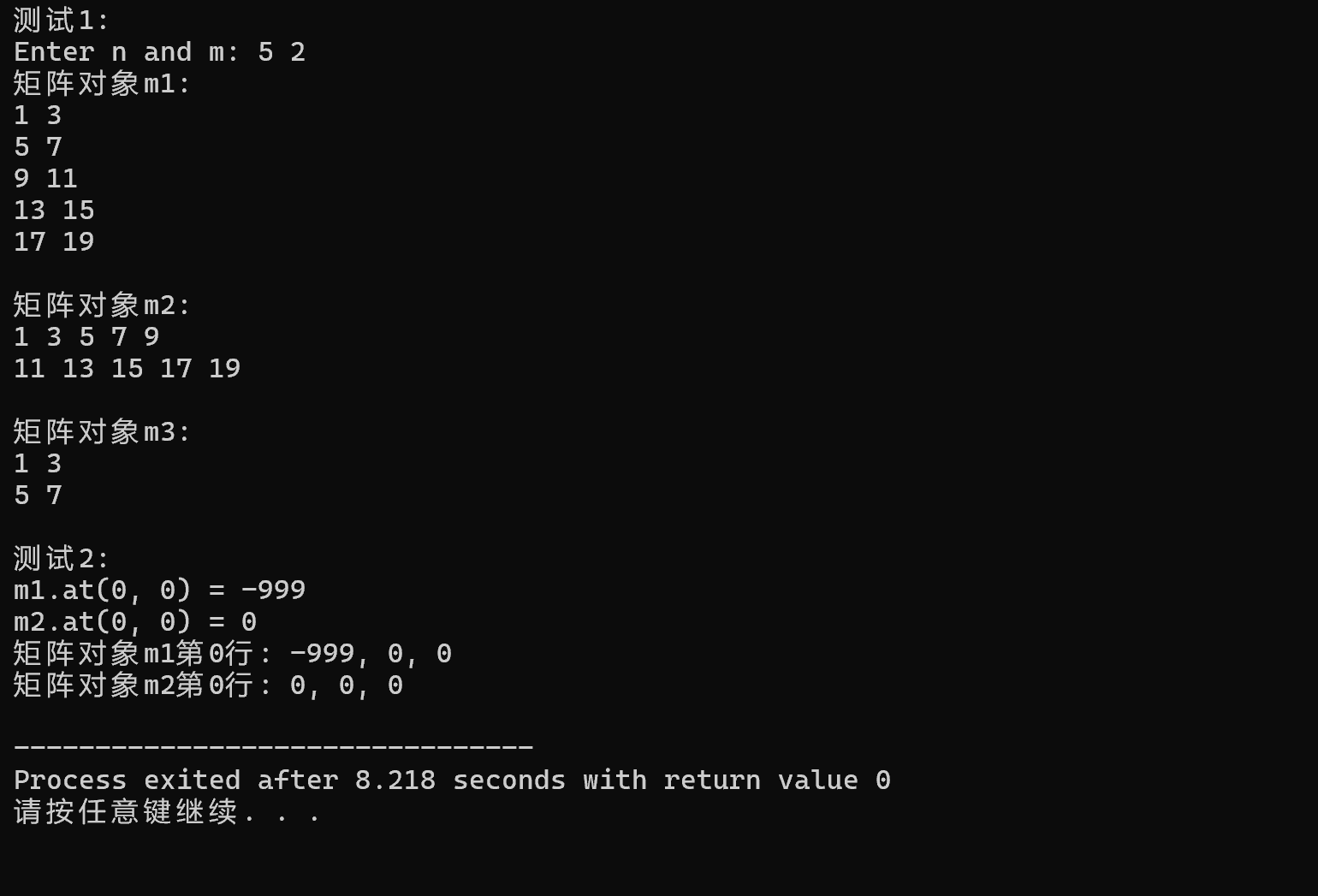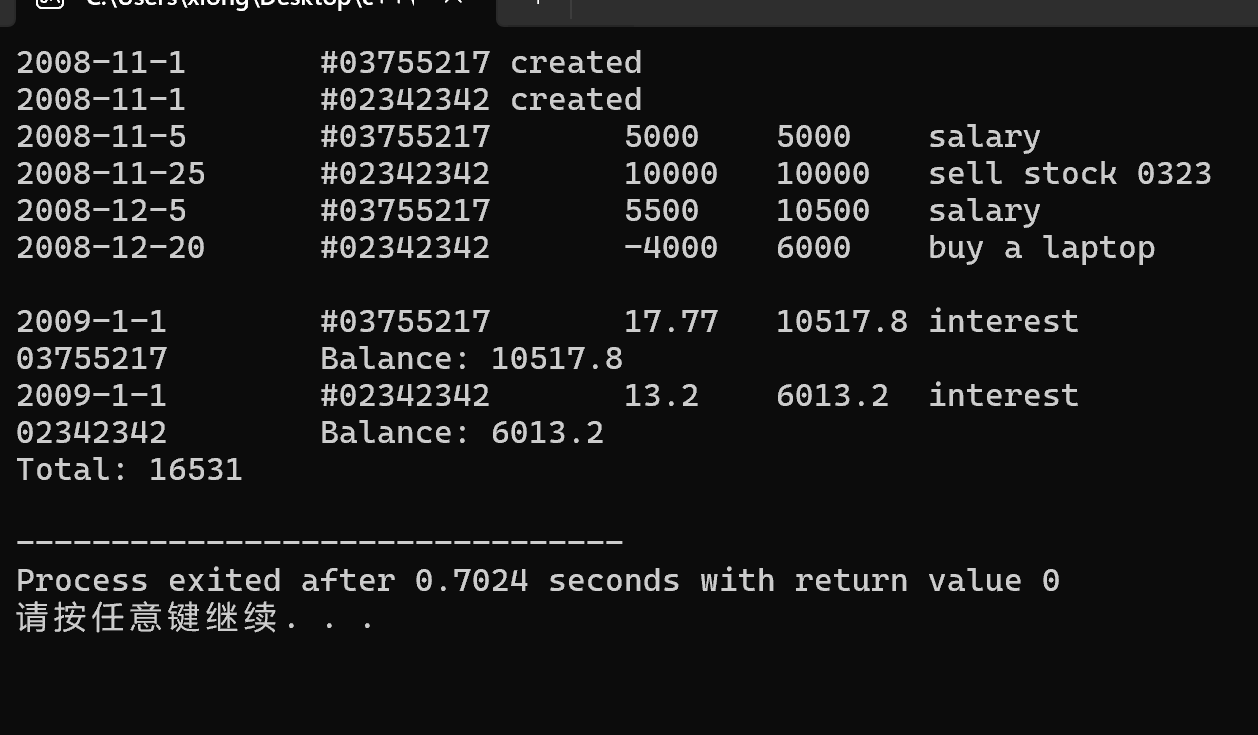实验三
任务1:
#include "window.hpp" #include <iostream> using std::cout; using std::cin; void test() { Window w1("new window"); w1.add_button("maximize"); w1.display(); w1.close(); } int main() { cout << "用组合类模拟简单GUI:\n"; test(); }
#pragma once #include <iostream> #include <string> using std::string; using std::cout; // 按钮类 class Button { public: Button(const string &text); string get_label() const; void click(); private: string label; }; Button::Button(const string &text): label{text} { } inline string Button::get_label() const { return label; } void Button::click() { cout << "Button '" << label << "' clicked\n"; }
#pragma once #include "button.hpp" #include <vector> #include <iostream> using std::vector; using std::cout; using std::endl; // 窗口类 class Window{ public: Window(const string &win_title); void display() const; void close(); void add_button(const string &label); private: string title; vector<Button> buttons; }; Window::Window(const string &win_title): title{win_title} { buttons.push_back(Button("close")); } inline void Window::display() const { string s(40, '*'); cout << s << endl; cout << "window title: " << title << endl; cout << "It has " << buttons.size() << " buttons: " << endl; for(const auto &i: buttons) cout << i.get_label() << " button" << endl; cout << s << endl; } void Window::close() { cout << "close window '" << title << "'" << endl; buttons.at(0).click(); } void Window::add_button(const string &label) { buttons.push_back(Button(label)); }
问题一:
自定义了2个类,使用了标准库的string,cin,cout,vector,endl。自定义的window和button有组合关系,vector和button有组合关系。
问题二:
不适合,const的作用是不让编译器改变变量的值,起到保护作用,加const的函数都是如展示display等不需要改变变量的函数,其他要改变的不能加const。而加inline是因为display操作调用次数较多,用内联函数来可以节省时间。
问题三:
这行代码创建了一个名为 s 的字符串对象,并且这个字符串由40个字符组成,每个字符都是星号(*)。
运行截图:

任务2:
代码:
#include <iostream> #include <vector> using namespace std; void output1(const vector<int> &v) { for(auto &i: v) cout << i << ", "; cout << "\b\b \n"; } void output2(const vector<vector<int>> v) { for(auto &i: v) { for(auto &j: i) cout << j << ", "; cout << "\b\b \n"; } } void test1() { vector<int> v1(5, 42); const vector<int> v2(v1); v1.at(0) = -999; cout << "v1: "; output1(v1); cout << "v2: "; output1(v2); cout << "v1.at(0) = " << v1.at(0) << endl; cout << "v2.at(0) = " << v2.at(0) << endl; } void test2() { vector<vector<int>> v1{{1, 2, 3}, {4, 5, 6, 7}}; const vector<vector<int>> v2(v1); v1.at(0).push_back(-999); cout << "v1: \n"; output2(v1); cout << "v2: \n"; output2(v2); vector<int> t1 = v1.at(0); cout << t1.at(t1.size()-1) << endl; const vector<int> t2 = v2.at(0); cout << t2.at(t2.size()-1) << endl; } int main() { cout << "测试1:\n"; test1(); cout << "\n测试2:\n"; test2(); }
运行截图:

问题一:
第一行代码创建了一个名为 v1 的 int 类型的 vector,它包含5个元素,每个元素的值都是42。
第二行代码将v1的值赋给v2。
第三行即将v1[0]赋值成-999.
问题二:
第一行行代码创建了一个一个二维的动态整数数组,这里,v1被初始化为包含两个子数组,第一个子数组包含{1, 2, 3},第二个子数组包含{4, 5, 6, 7}。
第二行将v1的值赋给v2。
第三行往v1的第一个子数组添加元素-999。
问题三:
t1是从 v1 的第一个元素(即 {1, 2, 3})复制得到的一维向量。
第二行是打印出t1的最后个元素即-999,第三行是将v2的第1个一维向量复制给t2。第四行是打印出t2的最后一个元素即3。
问题四:
标准库模板类 vector内部的复制构造函数实现的是深复制
模板类vector的接口at()确实至少需要提供一个 const 成员函数版本作为接口。这是因为at() 函数通常用于访问向量中的元素,并且有时我们需要在不修改向量内容的情况下读取这些元素。提供const成员函数版本可以确保在不改变对象状态的情况下进行安全的访问。
任务三:
代码:
#include "vectorInt.hpp" #include <iostream> using std::cin; using std::cout; void output(const vectorInt &vi) { for(auto i = 0; i < vi.get_size(); ++i) cout << vi.at(i) << ", "; cout << "\b\b \n"; } void test1() { int n; cout << "Enter n: "; cin >> n; vectorInt x1(n); for(auto i = 0; i < n; ++i) x1.at(i) = i*i; cout << "x1: "; output(x1); vectorInt x2(n, 42); vectorInt x3(x2); x2.at(0) = -999; cout << "x2: "; output(x2); cout << "x3: "; output(x3); } void test2() { const vectorInt x(5, 42); vectorInt y(10, 0); cout << "y: "; output(y); y.assign(x); cout << "y: "; output(y); cout << "x.at(0) = " << x.at(0) << endl; cout << "y.at(0) = " << y.at(0) << endl; } int main() { cout << "测试1: \n"; test1(); cout << "\n测试2: \n"; test2(); }
#pragma once #include <iostream> #include <cassert> using std::cout; using std::endl; // 动态int数组对象类 class vectorInt{ public: vectorInt(int n); vectorInt(int n, int value); vectorInt(const vectorInt &vi); ~vectorInt(); int& at(int index); const int& at(int index) const; vectorInt& assign(const vectorInt &v); int get_size() const; private: int size; int *ptr; // ptr指向包含size个int的数组 }; vectorInt::vectorInt(int n): size{n}, ptr{new int[size]} { } vectorInt::vectorInt(int n, int value): size{n}, ptr{new int[size]} { for(auto i = 0; i < size; ++i) ptr[i] = value; } vectorInt::vectorInt(const vectorInt &vi): size{vi.size}, ptr{new int[size]} { for(auto i = 0; i < size; ++i) ptr[i] = vi.ptr[i]; } vectorInt::~vectorInt() { delete [] ptr; } const int& vectorInt::at(int index) const { assert(index >= 0 && index < size); return ptr[index]; } int& vectorInt::at(int index) { assert(index >= 0 && index < size); return ptr[index]; } vectorInt& vectorInt::assign(const vectorInt &v) { delete[] ptr; // 释放对象中ptr原来指向的资源 size = v.size; ptr = new int[size]; for(int i = 0; i < size; ++i) ptr[i] = v.ptr[i]; return *this; } int vectorInt::get_size() const { return size; }
运行截图:

问题一:
深复制。
问题二:
不能正常运行,
如果修改,那么该方法将不再返回对向量中元素的直接引用,而是返回该元素的一个副本。这意味着,通过at()方法获得的任何值都将是向量中对应元素的一个快照,而不是对该元素的持久引用。去掉const存在安全隐患,如果去掉那么该方法将返回对向量中元素的非const引用。这意味着调用者可以通过这个引用来修改向量中的元素。
问题三:
可以,但不应该改,因为从性能来看,返回引用避免了不必要的对象复制,若改,则每次都可能涉及不必要的内存分配和元素复制。
任务四:
代码:
#pragma once #include <iostream> #include <cassert> using std::cout; using std::endl; // 类Matrix的声明 class Matrix { public: Matrix(int n, int m); // 构造函数,构造一个n*m的矩阵, 初始值为value Matrix(int n); // 构造函数,构造一个n*n的矩阵, 初始值为value Matrix(const Matrix &x); // 复制构造函数, 使用已有的矩阵X构造 ~Matrix(); void set(const double *pvalue); // 用pvalue指向的连续内存块数据按行为矩阵赋值 void clear(); // 把矩阵对象的值置0 const double& at(int i, int j) const; // 返回矩阵对象索引(i,j)的元素const引用 double& at(int i, int j); // 返回矩阵对象索引(i,j)的元素引用 int get_lines() const; // 返回矩阵对象行数 int get_cols() const; // 返回矩阵对象列数 void display() const; // 按行显示矩阵对象元素值 private: int lines; // 矩阵对象内元素行数 int cols; // 矩阵对象内元素列数 double *ptr; }; Matrix::Matrix(int n,int m):lines(n),cols(m) { int value=0; ptr=new double[n*m]; for(int i=0;i<lines*cols;i++) { ptr[i]=value; } } Matrix::Matrix(int n):lines(n),cols(n) { int value=0; ptr=new double[n*n]; for(int i=0;i<lines*cols;i++) { ptr[i]=value; } } Matrix::Matrix(const Matrix &x):lines(x.lines),cols(x.cols){ ptr=new double[x.lines*x.cols]; for(int i=0;i<lines*cols;i++) { ptr[i]=x.ptr[i]; } } Matrix::~Matrix() { delete[] ptr; } void Matrix::set(const double *pvalue) { for(int i=0;i<lines*cols;i++) { ptr[i]=pvalue[i]; } } void Matrix::clear() { for(int i=0;i<lines*cols;i++) { ptr[i]=0.0; } } const double& Matrix::at(int i, int j) const { return ptr[i*cols+j]; } double& Matrix::at(int i, int j) { return ptr[i*cols+j]; } int Matrix::get_lines() const { return lines; } int Matrix::get_cols() const { return cols; } void Matrix::display() const { for(int i=0;i<lines;i++) { for(int j=0;j<cols;j++) { cout<<at(i,j)<<" "; } cout<<endl; } }
#include "matrix.hpp" #include <iostream> #include <cassert> using std::cin; using std::cout; using std::endl; const int N = 1000; // 输出矩阵对象索引为index所在行的所有元素 void output(const Matrix &m, int index) { assert(index >= 0 && index < m.get_lines()); for(auto j = 0; j < m.get_cols(); ++j) cout << m.at(index, j) << ", "; cout << "\b\b \n"; } void test1() { double x[1000] = {1, 2, 3, 4, 5, 6, 7, 8, 9}; int n, m; cout << "Enter n and m: "; cin >> n >> m; Matrix m1(n, m); // 创建矩阵对象m1, 大小n×m m1.set(x); // 用一维数组x的值按行为矩阵m1赋值 Matrix m2(m, n); // 创建矩阵对象m1, 大小m×n m2.set(x); // 用一维数组x的值按行为矩阵m1赋值 Matrix m3(2); // 创建一个2×2矩阵对象 m3.set(x); // 用一维数组x的值按行为矩阵m4赋值 cout << "矩阵对象m1: \n"; m1.display(); cout << endl; cout << "矩阵对象m2: \n"; m2.display(); cout << endl; cout << "矩阵对象m3: \n"; m3.display(); cout << endl; } void test2() { Matrix m1(2, 3); m1.clear(); const Matrix m2(m1); m1.at(0, 0) = -999; cout << "m1.at(0, 0) = " << m1.at(0, 0) << endl; cout << "m2.at(0, 0) = " << m2.at(0, 0) << endl; cout << "矩阵对象m1第0行: "; output(m1, 0); cout << "矩阵对象m2第0行: "; output(m2, 0); } int main() { cout << "测试1: \n"; test1(); cout << "测试2: \n"; test2(); }
运行截图:

任务5:
代码:
#pragma once #include<iostream> #include<vector> #include<string> #include<chrono> #include<thread> using namespace std; class User{ private: string password={'1','2','3','4','5','6'}; string email; string name; public: User(string name1); User(string name1,string password1,string email1); void set_email(); void change_password(); void display(); }; User::User(string name1):name(name1){} User::User(string name1,string password1,string email1):name(name1),password(password1),email(email1){} void User::set_email() { cout<<"Enter email address: "; string s; while(true) { cin>>s; if(s.find('@')!=string::npos) { email=s; cout<<"email is set successfully..."<<endl; break; } else { cout<<"illegal email. Please re-enter email: "; } } } void User::change_password() { string s0; int i=0; s0=password; cout<<"Enter old password: "; while(true) { string s1; cin>>s1; i++; if(s1==s0) { cout<<"Enter new password: "; string s2; cin>>s2; password=s2; cout<<"new password is set successfully..."<<endl; break; } else { if(i>2) { int waittime=10; cout<<"password input error. Please try after 10 seconds."<<endl; this_thread::sleep_for(chrono::seconds(waittime)); } else cout<<"password input error. Please re-enter again: "; } } } void User::display() { int length; length=password.size(); string s4(length,'*'); cout<<"name: "<<name<<endl; cout<<"pass: "<<s4<<endl; cout<<"email: "<<email; }
#include "user.hpp" #include <iostream> #include <vector> #include <string> using std::cin; using std::cout; using std::endl; using std::vector; using std::string; void test() { vector<User> user_lst; User u1("Alice", "2024113", "Alice@hotmail.com"); user_lst.push_back(u1); cout << endl; User u2("Bob"); u2.set_email(); u2.change_password(); user_lst.push_back(u2); cout << endl; User u3("Hellen"); u3.set_email(); u3.change_password(); user_lst.push_back(u3); cout << endl; cout << "There are " << user_lst.size() << " users. they are: " << endl; for(auto &i: user_lst) { i.display(); cout << endl; } } int main() { test(); }
运行截图:

任务六:
代码:
#pragma once class Date { private: int year; int month; int day; int totalDays; public: Date(int year, int month, int day); int getYear() const { return year; } int getMonth() const { return month; } int getDay() const { return day; } int getMaxDay() const; bool isLeapYear() const { return year % 4 == 0 && year % 100 != 0 || year % 400 == 0; } void show() const; int distance(const Date& date) const { return totalDays - date.totalDays; } };
#include "date.h" #include <iostream> #include <cstdlib> using namespace std; namespace { const int DAYS_BEFORE_MONTH[] = { 0, 31, 59, 90, 120, 151, 181, 212, 243, 273, 304, 334, 365 }; } Date::Date(int year, int month, int day) : year(year), month(month), day(day) { if (day <= 0 || day > getMaxDay()) { cout << "Invalid date: "; show(); cout << endl; exit(1); } int years = year - 1; totalDays = years * 365 + years / 4 - years / 100 + years / 400 + DAYS_BEFORE_MONTH[month - 1] + day; if (isLeapYear() && month > 2) totalDays++; } int Date::getMaxDay() const { if (isLeapYear() && month == 2) return 29; else return DAYS_BEFORE_MONTH[month] - DAYS_BEFORE_MONTH[month - 1]; } void Date::show() const { cout << getYear() << "-" << getMonth() << "-" << getDay(); }
#pragma once #include "date.h" #include <string> using namespace std; class SavingsAccount { private: string id; double balance; double rate; Date lastDate; double accumulation; static double total; void record(const Date& date, double amount, const string& desc); void error(const string& msg) const; double accumulate(const Date& date) const { return accumulation + balance * date.distance(lastDate); } public: SavingsAccount(const Date& date, const string& id, double rate); const string& getId() const { return id; } double getBalance() const { return balance; } double getRate() const { return rate; } static double getTotal() { return total; } void deposit(const Date& date, double amount, const string& desc); void withdraw(const Date& date, double amount, const string& desc); void settle(const Date& date); void show() const; };
#include "account.h" #include <cmath> #include <iostream> using namespace std; double SavingsAccount::total = 0; SavingsAccount::SavingsAccount(const Date& date, const string& id, double rate) : id(id), balance(0), rate(rate), lastDate(date), accumulation(0) { date.show(); cout << "\t#" << id << " created" << endl; } void SavingsAccount::record(const Date& date, double amount, const string& desc) { accumulation = accumulate(date); lastDate = date; amount = floor(amount * 100 + 0.5) / 100; balance += amount; total += amount; date.show(); cout << "\t#" << id << "\t" << amount << "\t" << balance << "\t" << desc << endl; } void SavingsAccount::error(const string& msg) const { cout << "Error(#" << id << "):" << msg << endl; } void SavingsAccount::deposit(const Date& date, double amount, const string& desc) { record(date, amount, desc); } void SavingsAccount::withdraw(const Date& date, double amount, const string& desc) { if (amount > getBalance()) error("not enough money"); else record(date, -amount, desc); } void SavingsAccount::settle(const Date& date) { double interest = accumulate(date) * rate / date.distance(Date(date.getYear() - 1, 1, 1)); if (interest != 0) record(date, interest, "interest"); accumulation = 0; } void SavingsAccount::show() const { cout << id << "\tBalance: " << balance; }
#include "account.h" #include <iostream> using namespace std; int main() { Date date{ 2008, 11, 1 }; SavingsAccount accounts[] = { SavingsAccount(date, "03755217", 0.015), SavingsAccount(date, "02342342", 0.015) }; const int n = sizeof(accounts) / sizeof(SavingsAccount); accounts[0].deposit(Date(2008, 11, 5), 5000, "salary"); accounts[1].deposit(Date(2008, 11, 25), 10000, "sell stock 0323"); accounts[0].deposit(Date(2008, 12, 5), 5500, "salary"); accounts[1].withdraw(Date(2008, 12, 20), 4000, "buy a laptop"); cout << endl; for (int i = 0; i < n; i++) { accounts[i].settle(Date(2009, 1, 1)); accounts[i].show(); cout << endl; } cout << "Total: " << SavingsAccount::getTotal() << endl; return 0; }
运行截图:




